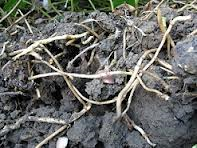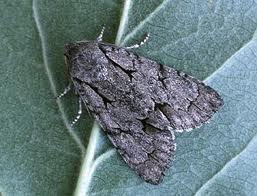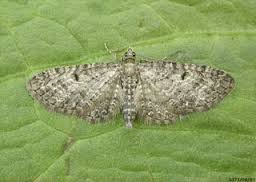Aegopodium podagraria L. Ground Elder,
This plant has the reputation as one of the worst of garden weeds. since it spreads in all directions extremely rapidly by means of its underground stems.
It is known by a variety of names amongst which ,Herb Gerard, Bishop’s weed, goutweed, and snow-in-the-mountain, and sometimes called English masterwort, and wild masterwort although other names, such as Farmers plague and jump about may be especially apt. Gound elder is a perennial plant in the carrot family (Apiacae) that grows to a height of 100 cms in shady places. The name “ground elder” comes from the superficial similarity of its leaves and flowers to those of elder (Sambucus), which is unrelated. This species is native to Eurasia, and has been introduced around the world as an ornamental plant, where it occasionally poses an ecological threat as an invasive plant.
Structure
Goutweed, also known as bishop’s-weed and snow-on-the-mountain, is a herbaceous perennial plant. It is one of several species of Aegopodium, native to Europe and Asia. Most leaves are basal, with the leafstalk attached to an underground stem, or rhizome. The leaves are divided into three groups of three leaflets, making it “triternate.” The leaflets are toothed and sometimes irregularly lobed. Foliage of the “wild” type is medium green in color; a commonly planted variegated form has bluish-green leaves with creamy white edges. Sometimes reversion back to solid green or a mixture of solid green and the lighter variegated pattern occurs within a patch. The stems are erect, hollow and grooved. When crushed the foliage emits a characteristic odour which is at once pungent and aromatic. The two halves of the fruit are five angled and unlike most Umbelliferae, there are no oil ducts in the wall, this can be observed when the ripe fruit is cut across. the seedling leaves appear as unexpanded blades bent down against the leaf stalk and it is only the stimulus of light which causes the bent upper part of the leaf stalk to straighten when it has pushed its way through the screening leaf litter and soil.

Small, white, five-petaled flowers are produced in mid-summer. Flowers are arranged in flat-topped clusters (called compound umbels) and are held above the ground on a leafy stem up to about 3 feet tall. The seeds are small and elongate, similar in size and shape to carrot seeds, and ripen in late summer. although flowering freely seedlings are not often found. the plant tends to spread from vegetative growth of the underground rhizomes. In contrast to the dense foliage cover produced by goutweed, flowering shoots are uncommon in densely shaded areas.

The rhizomes of goutweed are long, white, and branching, superficially resembling those of quackgrass (Elytrigia repens, also known as Agropyron repens). Patches of goutweed typically form a dense canopy and can exclude most other herbaceous vegetation.
Mabey relates that after digging up a herbaceous border removing all the rhizomes from the soil and from the roots of plants taken from the soil small shoots continued to emerge the following year.
“Here and there, near the edges of the bed, I found a few small leaflets unfolding. I carefully extricated the plants trying not to break the roots, to see what they had emerged from. Each seemed to have sprung from a small section of cut root thin enough to have been overlooked in the great cleansing. And the new shoots were growing not from nodes along the serpentine root fragments as in some species, but from a bulbous swelling at its tip.”

History
No evidence of the presence of ground elder has been found in prehistoric excavations although it appears in Roman deposits. the Romans valued it as a medicinal herb for treating gout and as a vegetable. Mabey suggests that the plant was introduced by the Romans like the plants Alexanders and fennel, two other species introduced by the Romans that naturalised rapidly. It soon became naturalised and began to pick up folk names. The names goutweed and Bishop’s weed are references to the properties of the plant in alleviating that aliment. Presumably Bishops were particularly prone to gout because of their high protein diet. Most peasants would not have had such a protein rich diet. it was certainly widely cultivated as a pot herb. The first published record for ground elder is from Lyte’s herbal of 1578. Jack-Jump-About appears as a name in the sixteenth century. It was described rather ominously by Gerard in his herbal at the end of the sixteenth century in desperate tones.
“where it hath once taken roote it will hardly be gotten out againe, spoiling and getting every yeere more ground, to the annoying of better herbes”
This encroachment of ground elder is well recorded and refers to the ability of the plant to grow up to 3 feet underground in a single season. Consequently, from one rosette an area of almost a square metre has been found colonised at the end of one year.
Invasive habit
Ground elder is an aggressive invasive plant that forms dense patches, displaces native species, and greatly reduces species diversity in the ground layer. Goutweed patches inhibit the establishment of conifers and other native tree species as well. Seed dispersal and seedling establishment is typically limited by shading, and new establishments from seed are restricted to disturbed areas. However, Aegopodium podagraria readily spreads over large areas of ground by underground rhizomes. The underground stems spread and branch below the surface usually at a depth of 1.5 to 2 inches. however Mabey reports that in a quarry in the 1990s a worker found roots of ground elder probing 30 feet below the surface. In the angle between each scale leaf and the rhizome that bears it, there is an axillary bud that has the potential to develop into a new branch rhizome. At the end of the rhizome a leafy shoot emerges from the basal leaves from which axillary buds can grow to form rhizomes.Once established, the plants are highly competitive, and can reduce the diversity of ground cover, preventing the establishment of tree and shrub seedlings. Because of its limited seed dispersal ability and seedling recruitment, the primary vector for dispersal to new areas are human plantings as an ornamental, medicinal or vegetable plant, as well as by accidentally spreading rhizomes by dumping of garden waste. It spreads rapidly under favorable growing conditions. Because of this it has been described as a nuisance species, and been labeled one of the “worst” garden weeds in perennial flower gardens.

A. podagraria has been introduced around the world, including in North America, Australia, New Zealand, and Japan, most commonly as an ornamental plant. It readily establishes and can become naturalized in boreal, moist-temperate, and moist-subtropical climates. It is an “aggressive” invader in the upper Great Lakes region and northeastern North America, Australia, Tasmania, and New Zealand Most colonies spread to neighboring natural areas from intentional plantings, or by the dumping of yard waste that includes discarded rhizomes. It can pose an ecological threat due to its invasive nature, with potential to crowd out native species. Because of its potential impacts on native communities and the difficulty of its control, it has been banned or restricted in some jurisdictions outside its native range, including in Connecticut, Massachusetts, and Vermont in the USA.
Control
Rhizomes developing new shoots
Once established, goutweed is difficult to eradicate. The smallest piece of rhizome left in the ground will quickly form a sturdy new plant. All-green goutweed may be more persistent and spread more rapidly than ornamental, variegated goutweed varieties, making the all-green type particularly difficult to control. However, all-green, forms are known to reappear from seeds of variegated varieties. Systemic herbicides such as glyphosate (Roundup®) that are translocated to the roots and kill the entire plant are most effective for goutweed control. However, glyphosate is non-specific and can damage or kill desirable native plants that are accidentally sprayed in the course of treating the goutweed. Contact herbicides are usually ineffective because goutweed readily leafs out again after defoliation. Personally, even after treatment with glyphosate I have found the plants regrow. This weed is by general agreement one of the most difficult to eradicate, except by laborious hand weeding.
Manual
Small patches of goutweed can be eliminated by careful and persistent hand-pulling or digging up of entire plants along with underground stems (rhizomes). Pulled plants can be piled up and allowed to dry for a few days before bagging and disposing of them. Be careful to pick up all rhizomes which, if left can re-root and sprout new plants. For large patches, a team of volunteers or use of herbicide is recommended. the rhizomes penetrate not only the soil but the root system of any plants growing in that soil. therefore in order to eliminate the ground elder, it is necessary to separate any rhizomes from within the root systems of plants growing in the borders, a laborious and tiresome procedure. Any small pieces of rhizome that break off can regrow and any fragments of rhizome left in the root systems of other plats can regrow.
Mechanical
Where appropriate, frequent short mowing may control or slow the spread of goutweed in lawns, along roadsides, and other areas.
Physical
Preventing goutweed from photosynthesizing in early spring (at the time of leaf-out) can control the plant by depleting its carbohydrate reserves. This can be accomplished by covering the patch with black plastic sheeting when the leaves start to emerge from the ground in the spring, and leaving it in place through the summer. A more effective option is to cut all plants once they’ve fully leafed out, using a mower, scythe, or weed-whacker type machine, and then cover the area with plastic. Covering the plants in mid- or late summer, after they have regained substantial starch reserves, is probably much less effective.
Integrative management strategies that combine herbicide with landscape cloth, bark mulch, and hand weeding to control goutweed in a garden are largely unsuccessful because sprouting occurs from either rhizomes or root fragments left in the soil Hand pulling, raking, and digging followed by monitoring to control goutweed may be effective; however, caution must be taken to remove the entire rhizome and root system. Removing flowers before seed set may help control the spread of goutweed.] Because goutweed’s starch reserves are typically depleted by spring, removal of leaves in spring could be effective in starving the plant. Once goutweed has been removed, the patch should be carefully monitored periodically for a few years. New shoots should be dug up and destroyed. Revegetation with other plant materials is recommended.
The most effective means of control is to prevent its establishment in natural communities. It is thus recommended to plant goutweed only on sites not adjacent to wildlands and in gardens where root spread can be restricted.
Ornamental use
A variegated form is grown as an ornamental plant though with the advice to keep it isolated.
Importance to wildlife
It is used as a food plant by the larvae of some species of Lepidoptera, including dot moth, grey dagger and grey pug, although A. podagraria is not the exclusive host to any of these species.
Dot Moth

Stem profile – no toxic look-alike has a triangular profile.
Uses as food and medicine
The plant is said to have been introduced into England by the Romans as a food plant. The tender leaves have been used in antiquity and throughout the Middle Ages as a spring vegetable, similar to spinach. It was called Bishopsweed and Bishopswort, because so frequently found near old ecclesiastical ruins. It is said to have been introduced by the monks of the Middle Ages, who cultivated it as a herb of healing. It was called Herb Gerard, because it was dedicated to St. Gerard, who was formerly invoked to cure the gout, against which the herb was chiefly employed. Descriptions of its use are found among monastic writings, such as in Physica by Hildegard von Bingen. Gerard tells us that:
‘with his roots stamped and laid upon members that are troubled or vexed with gout, swageth the paine, and taketh away the swelling and inflammation thereof, which occasioned the Germans to give it the name of Podagraria, because of his virtues in curing the gout.’
Young leaves are preferred as a pot herb. It is best picked from when it appears (as early as February in the UK) to just before it flowers (May to June). If it is picked after this point, it takes on a pungent taste and has a laxative effect. However, it can be stopped from flowering by pinching out the flowers, ensuring the plant remains edible if used more sparingly as a pot herb.
It also had a history as a medicinal herb to treat gout and atthritis] applied in hot wraps externally upon boiling both leaves and roots together. The generic name is a corruption of the Greek aix, aigos (a goat) and pous, podos (a foot), from some fancied resemblance in the shape of the leaves to the foot of a goat. The specific name is derived from the Latin word for gout, podagra, because it was at one time a specific for gout.
Ingested, the leaves have a diuretic effect and act as a mild sedative. Its use as a medicinal herb has largely declined during the modern era.
1. “The Plant List: A Working List of All Plant Species”. Retrieved 5 December 2014.
2. a b Goutweed (Aegopodium podagraria) Mrs. Grieve’s “A Modern Herbal” at Botanical.com]
3. a b “Plant Conservation Alliance, Alien Plant Working Group: Goutweed”.
4. Webb, D.A., Parnell, J. and Doogue, D. 1996. An Irish Flora. Dundalgan Press Ltd, Dundalk. ISBN 0-85221-131-7
5. a b Agronomy Division (1969). “Ground elder (Aegopodium podagraria)”. Tasmanian Journal of Agriculture 40 (30): 190.
6. a b Dawson, F. Hugh; Holland, David. (1999). “The distribution in bankside habitats of three alien invasive plants in the U.K. in relation to the development of control strategies.”. Hydrobiologia 15: 193–201. doi:10.1007/978-94-017-0922-4_27.
7. ^ “US Forest Service, Aegopodium podagraria”.
8. “The USDA PLANTS Database. National Plant Data Center, Natural Resources Conservation Service, United States Department of Agriculture. Baton Rouge, LA.”.
9. Clark, Frances H.; Mittrick, Chris; Shonbrun, Sarah. (1998). “Rogues gallery: New England’s notable invasives.”. Conservation Notes of the New England Wild Flower Society 2 (3): 19–26.
10. Czarapata, Elizabeth J. (2005). Invasive plants of the Upper Midwest: An illustrated guide to their identification and control. pp. 215 p.
“Ground Elder – Bishops Weed (Aegopodium podagraria)”. Edible Plants. 2009. Retrieved 2010-02-15.
12. Richard Mabey Weeds 2010 Profile books London
13. Sir Edward Salisbury Weeds and Aliens The New Naturalist Collins London 1961

